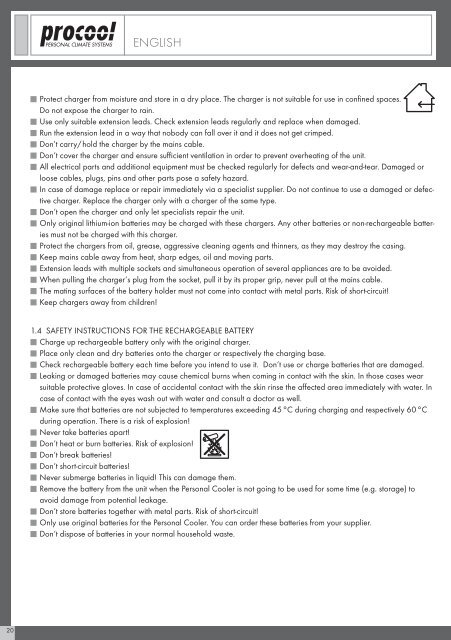BEDIENUNGSANLEITUNG OPERATING INSTRUCTIONS - Entrak
BEDIENUNGSANLEITUNG OPERATING INSTRUCTIONS - Entrak
BEDIENUNGSANLEITUNG OPERATING INSTRUCTIONS - Entrak
Sie wollen auch ein ePaper? Erhöhen Sie die Reichweite Ihrer Titel.
YUMPU macht aus Druck-PDFs automatisch weboptimierte ePaper, die Google liebt.
20<br />
ENGLISH ENGLISH<br />
Protect charger from moisture and store in a dry place. The charger is not suitable for use in confined spaces.<br />
Do not expose the charger to rain.<br />
Use only suitable extension leads. Check extension leads regularly and replace when damaged.<br />
Run the extension lead in a way that nobody can fall over it and it does not get crimped.<br />
Don’t carry/hold the charger by the mains cable.<br />
Don‘t cover the charger and ensure sufficient ventilation in order to prevent overheating of the unit.<br />
All electrical parts and additional equipment must be checked regularly for defects and wear-and-tear. Damaged or<br />
loose cables, plugs, pins and other parts pose a safety hazard.<br />
In case of damage replace or repair immediately via a specialist supplier. Do not continue to use a damaged or defec-<br />
tive charger. Replace the charger only with a charger of the same type.<br />
Don‘t open the charger and only let specialists repair the unit.<br />
Only original lithium-ion batteries may be charged with these chargers. Any other batteries or non-rechargeable batteries<br />
must not be charged with this charger.<br />
Protect the chargers from oil, grease, aggressive cleaning agents and thinners, as they may destroy the casing.<br />
Keep mains cable away from heat, sharp edges, oil and moving parts.<br />
Extension leads with multiple sockets and simultaneous operation of several appliances are to be avoided.<br />
When pulling the charger‘s plug from the socket, pull it by its proper grip, never pull at the mains cable.<br />
The mating surfaces of the battery holder must not come into contact with metal parts. Risk of short-circuit!<br />
Keep chargers away from children!<br />
1.4 SAFETY <strong>INSTRUCTIONS</strong> FOR THE RECHARGEABLE BATTERY<br />
Charge up rechargeable battery only with the original charger.<br />
Place only clean and dry batteries onto the charger or respectively the charging base.<br />
Check rechargeable battery each time before you intend to use it. Don‘t use or charge batteries that are damaged.<br />
Leaking or damaged batteries may cause chemical burns when coming in contact with the skin. In those cases wear<br />
suitable protective gloves. In case of accidental contact with the skin rinse the affected area immediately with water. In<br />
case of contact with the eyes wash out with water and consult a doctor as well.<br />
Make sure that batteries are not subjected to temperatures exceeding 45 °C during charging and respectively 60 °C<br />
during operation. There is a risk of explosion!<br />
Never take batteries apart!<br />
Don‘t heat or burn batteries. Risk of explosion!<br />
Don‘t break batteries!<br />
Don‘t short-circuit batteries!<br />
Never submerge batteries in liquid! This can damage them.<br />
Remove the battery from the unit when the Personal Cooler is not going to be used for some time (e.g. storage) to<br />
avoid damage from potential leakage.<br />
Don‘t store batteries together with metal parts. Risk of short-circuit!<br />
Only use original batteries for the Personal Cooler. You can order these batteries from your supplier.<br />
Don‘t dispose of batteries in your normal household waste.<br />
2 EQUIPMENT CONFIGURATION AND MODE OF OPERATION<br />
2.1 EQUIPMENT CONFIGURATION<br />
1 Cooling packs<br />
2 Diffuser<br />
3 Attachment points<br />
4 Casing<br />
5 Operating controls + display<br />
6 Battery<br />
7 Ventilator<br />
8 Insulation shield<br />
3<br />
2.2 MODE OF OPERATION<br />
The basis of the Personal Cooler is a cold-storage facility in the form of two cool packs. The air<br />
from the protective suit is passed over the surface of the frozen cool packs for cooling. There it cools<br />
off and is then transferred back to the protective suit, cooling the entire body. The cooling effect<br />
is particularly pronounced in the areas of the upper half of the body and around the head.<br />
5<br />
2<br />
2.2.1 Appropriate Use<br />
The Personal Cooler is mounted on the body and is intended for use with a sealed protective suit. Alternative uses to the<br />
ones described here lead to changed operational characteristics.<br />
The particular form of the diffuser enables effective cooling, particularly of the upper body right up to the head. The ideal<br />
effect is achieved when the suit doesn‘t form a restricting fold between the unit and the breathing mask, which could block<br />
the free flow of air.<br />
Note:<br />
Never use the unit without a diffuser.<br />
For best results and optimal cooling position the unit approximately 20 cm below the chin. Make sure that freedom of<br />
movement is maintained at all times, in order to facilitate the wearing of any necessary masks/respirators.<br />
2.2.2 Ambient Conditions<br />
The Personal Cooler has been designed to be worn in conjunction with sealed protective suits.<br />
2.2.3 Length of Application<br />
The cool packs provide effective cooling between 30 to 60 minutes depending on the temperatures generated in the<br />
protective suit and the chosen mode of operation.<br />
The energy supply through the battery allows application of 2 to 3 hours. An extended length of application is possible<br />
through the use of additional cool packs and extra batteries.<br />
6<br />
4<br />
7<br />
1<br />
3<br />
3<br />
8<br />
21


